
The SD80MAC was a 5,000 horsepower (3.7 MW) C-C diesel-electric locomotive. It was powered by a 20-cylinder version of EMD's 710G prime mover, and was the second diesel locomotive by GM-EMD to use a V20 engine, since EMD's SD45 series. It introduced a wide radiator housing similar to GE Transportation locomotives and the placement of dynamic brakes at the rear of the locomotive, which is a quieter location, features that were incorporated into the SD90MAC and SD70ACe models. Key spotting differences between the SD80MAC and SD90MAC include no external rear sandbox on the SD90MAC, no rear lighted number boards on the SD90MAC, and the placement of the front numberboards. The SD80MAC also had recessed red marker lights in the nose, an identifying feature unique to Conrail (CR) locomotives, although Norfolk Southern (NS) had removed the lights on most of their former Conrail engines.

Under the Whyte notation for the classification of steam locomotives, a 2-10-4 locomotive has two leading wheels on one axle, usually in a Bissel truck, ten coupled driving wheels on five axles, and four trailing wheels on two axles, usually in a bogie. These were referred to as the Texas type in most of the United States, the Colorado type on the Burlington Route, and the Selkirk type in Canada.

A 2-8-8-4 steam locomotive, under the Whyte notation, has two leading wheels, two sets of eight driving wheels, and a four-wheel trailing truck. The type was generally named the Yellowstone, a name given it by the first owner, the Northern Pacific Railway, whose lines ran near Yellowstone National Park. Seventy-two Yellowstone-type locomotives were built for four U.S. railroads.
In railway engineering, the term tractive effort describes the pulling or pushing capability of a locomotive. The published tractive force value for any vehicle may be theoretical—that is, calculated from known or implied mechanical properties—or obtained via testing under controlled conditions. The discussion herein covers the term's usage in mechanical applications in which the final stage of the power transmission system is one or more wheels in frictional contact with a railroad track.

Under the Whyte notation for the classification of steam locomotives, 4-8-4 represents the wheel arrangement of four leading wheels on two axles, eight powered and coupled driving wheels on four axles and four trailing wheels on two axles. The type was first used by the Northern Pacific Railway, and initially named the Northern Pacific, but railfans and railroad employees have shortened the name since its introduction. It is most-commonly known as a Northern.
Under the Whyte notation for the classification of steam locomotives, 2-10-0 represents the wheel arrangement of two leading wheels on one axle, ten powered and coupled driving wheels on five axles, and no trailing wheels. This arrangement was often named Decapod, especially in the United States, although this name was sometimes applied to locomotives of 0-10-0 "Ten-Coupled" arrangement, particularly in the United Kingdom. Notable German locomotives of this type include the war locomotives of Class 52.

A locomotive booster for steam locomotives is a small supplementary two-cylinder steam engine back-gear-connected to the trailing truck axle on the locomotive or one of the trucks on the tender. It was invented in 1918 by Howard L. Ingersoll, assistant to the president of the New York Central Railroad.
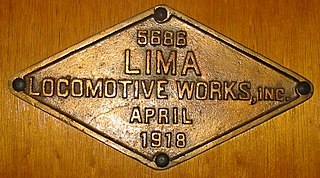
Lima Locomotive Works was an American firm that manufactured railroad locomotives from the 1870s through the 1950s. The company took the most distinctive part of its name from its main shop's location in Lima, Ohio. The shops were located between the Erie Railroad main line, the Baltimore & Ohio's Cincinnati-Toledo main line and the Nickel Plate Road main line and shops.
A 2-8-8-2, in the Whyte notation for describing steam locomotive wheel arrangements, is an articulated locomotive with a two-wheel leading truck, two sets of eight driving wheels, and a two-wheel trailing truck. The equivalent UIC classification is, refined to Mallet locomotives, (1'D)D1'. These locomotives usually employ the Mallet principles of articulation—with the rear engine rigidly attached to the boiler and the front engine free to rotate—and compounding. The 2-8-8-2 was a design largely limited to American locomotive builders. The last 2-8-8-2 was retired in 1962 from the N&W's roster, two years past the ending of steam though steam was still used on steel mill lines and other railroads until 1983.

Under the Whyte notation for the classification of steam locomotives, a 4-8-8-2 is a locomotive with four leading wheels, two sets of eight driving wheels, and a two-wheel trailing truck.
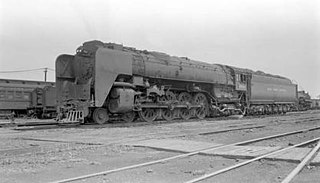
The New York Central Railroad's Niagara was a class of 27 4-8-4 steam locomotives built by the American Locomotive Company for the New York Central Railroad. Like many railroads that adopted different names for their 4-8-4s rather than “Northerns”, the New York Central named them “Niagaras”, named after the Niagara River and Falls. It is considered as one of the most efficient 4-8-4 locomotives ever built.
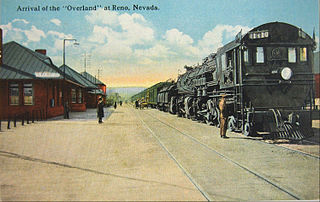
Southern Pacific Company's MM-2 class of steam locomotives was one of Southern Pacific's (SP) only classes of 2-6-6-2 locomotives ordered and built as oil-fired cab forward locomotives. They were built in 1911 as compound-expansion Mallet locomotives by Baldwin Locomotive Works and entered service on SP beginning September 19, 1911. By 1914, they had all been upgraded with an additional leading axle making them 4-6-6-2 locomotives, reclassified from MM-2 to AM-2. This was done to improve handling at speed. These locomotives were the predecessors of several other cab-forward engines, culminating in the AC-12 class cab forward locomotives built during World War II.
A triplex locomotive was a steam locomotive that divided the driving force on its wheels by using three pairs of cylinders to drive three sets of driving wheels. Any such locomotive will inevitably be articulated. All triplex locomotives built were of the Mallet type, but with an extra set of driving wheels under the tender. The concept was extended to locomotives with four, five or six sets of drive wheels. However, these locomotives were never built, except for one quadruplex locomotive in Belgium.
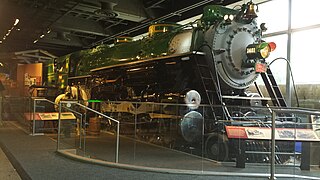
Southern Railway 1401 is a 4-6-2 steam locomotive built in July 1926 by the American Locomotive Company (ALCO) of Richmond, Virginia for the Southern Railway (SOU) as a member of the Ps-4 class, which was based on the United States Railroad Administration (USRA) Heavy Pacific design with some minor differences. It was assigned to haul the SOU's Crescent Limited passenger train between Washington, D.C., and Atlanta, Georgia.
The PRR J1 was a class of 2-10-4 "Texas" type steam locomotives built between 1942 and 1944. The J1 had over 95,000 pounds-force (422.6 kN) of tractive effort, plus an additional 15,000 lbf (66.7 kN) if the booster engine was used.
Southern Pacific Company's AM-2 class of steam locomotives was Southern Pacific's (SP) only class of 4-6-6-2 locomotives ordered and built as cab forward locomotives. They were actually MM-2s that had been upgraded. MM-2s were built in 1911 by Baldwin Locomotive Works and entered service on SP beginning September 19, 1911. By 1914, they had all been upgraded with an additional leading axle making them 4-6-6-2 locomotives. They reclassified their MM-2 as AM-2. This was done to improve handling at speed. These locomotives were the predecessors of the AC-12 class cab forward locomotives built during World War II.
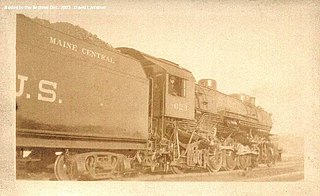
Maine Central Railroad Class S locomotives were intended for heavy freight service. They were of 2-8-2 wheel arrangement in the Whyte notation, or " 1'D1' " in UIC classification. They replaced earlier class W 2-8-0 locomotives beginning in 1914. They were the largest and most modern steam freight locomotives built for Maine Central; although former Boston and Maine Railroad 2-10-2s were later purchased to handle World War II freight traffic. Class S locomotives pulled freight trains over the main line between Portland and Bangor, Maine; and are best remembered for service on the Mountain Division from 1929, when the class X Mallet locomotives were scrapped, until replacement by diesel locomotives in the early 1950s.
Maine Central Railroad Class O locomotives were originally intended for heavy freight service. They were of 4-6-0 wheel arrangement in the Whyte notation, or "2'C" in UIC classification. They replaced earlier class P 2-6-0 locomotives beginning in 1903. They were in turn replaced by class W 2-8-0 locomotives for the heaviest freight service beginning in 1910, but remained in use on branch line trains until replaced by diesel locomotives after World War II. They proved so well-suited for branch line service the design was among the last steam locomotives built for the Maine Central.

Maine Central Railroad Class C locomotives were intended for main line passenger service. They were of 4-6-2 wheel arrangement in the Whyte notation, or " 2'C1' " in UIC classification. They replaced earlier class N 4-6-0 locomotives beginning in 1907. Class C locomotives pulled named passenger trains until replacement by diesel locomotives after World War II.

The Mateni class (マテニ) locomotives were a class of steam tender locomotives of the Chosen Government Railway (Sentetsu) with 4-8-2 wheel arrangement. The "Mate" name came from the American naming system for steam locomotives, under which locomotives with 4-8-2 wheel arrangement were called "Mountain".













